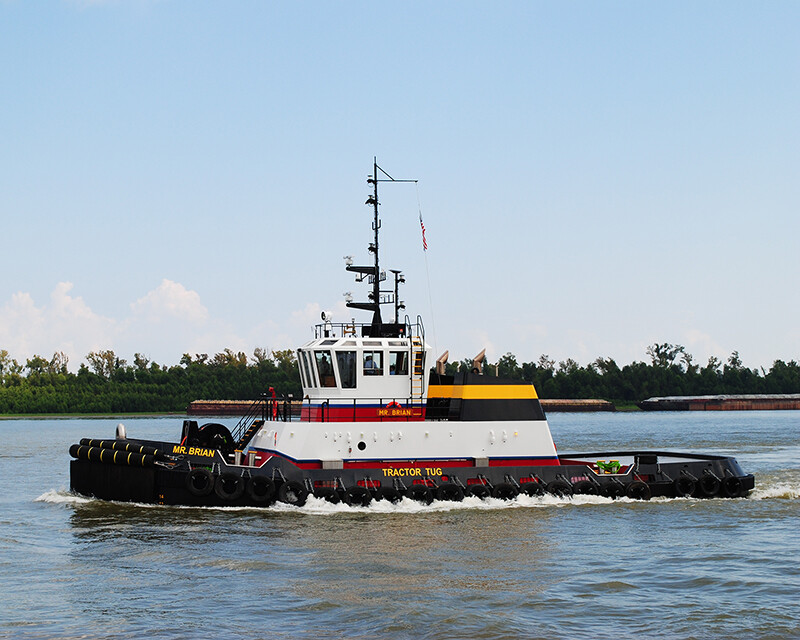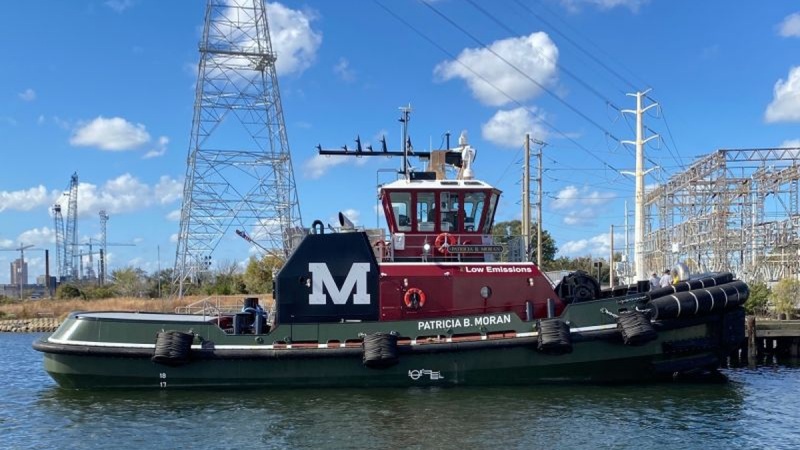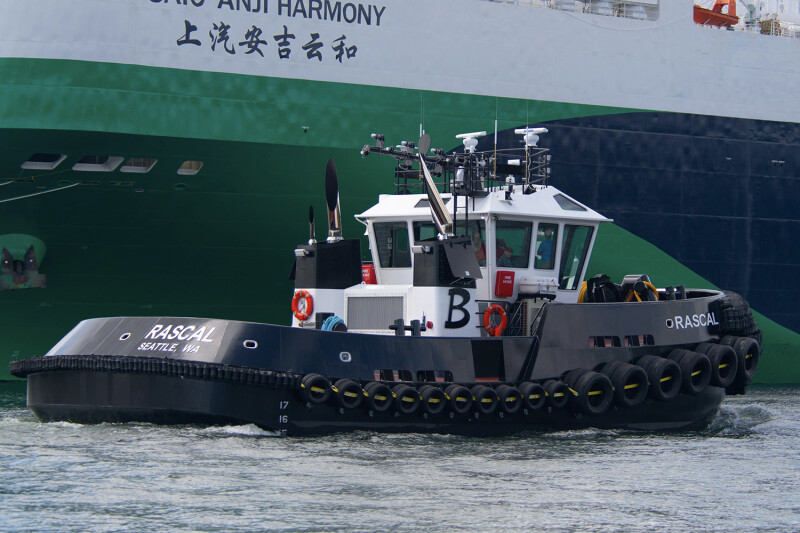Way back in 1999, Bisso Towboat Co. put the first azimuthing-sterndrive (ASD) tugboat into service on the Lower Mississippi River. Over time, the Luling, La., towing company added another and another.
The company’s president, Scott Slatten, set a goal along the way to build an entire fleet of ASD ship-assist tugboats. Bisso reached that milestone late last year with the delivery of the 96’x38’ Mr. Brian from Main Iron Works, Houma, La.
The 5,000-hp tugboat is based on a proven Castleman Maritime design that’s been refined with each successive delivery. Mr. Brian is Bisso’s 10th ASD tug and its sixth new delivery in nine years. It replaced the conventional tugboat Scott T. Slatten, built in 1995.

“We have invested in our equipment and our people, and I feel a lot better about our company moving forward,” Slatten said. “We have realized our dream to have a fleet that is all ASD tugs.”
Fleet renewal projects like this one have accelerated in recent years as tugboat operators on all three coasts replace older equipment with newer, higher-performing tugs. Regulatory changes such as the arrival of the U.S. Coast Guard Subchapter M inspection regime hastened vessel retirements. Covid-era inflation and supply-chain snags made older tugboats more expensive and challenging to maintain.
Plenty of other operators are running a similar playbook to modernize their equipment. The Great Lakes Towing Co., Cleveland, which operates ship-assist tugs from Duluth, Minn., to Buffalo, N.Y., is perhaps the best example. The company’s fleet of historic single-screw “G tugs” (for the letter emblazoned on their stacks) has supported ore, coal, and grain shipments throughout the region for more than a century.
That once prodigious fleet of G tugs has fallen to just 24, working primarily in smaller ports throughout the Great Lakes. They’ve largely been replaced by nine Cleveland-class tugboats built in-house by Great Lakes Shipyard in Cleveland over the last seven years. New York, delivered in fall 2024, is the most recent of the 64'x24', 2,000-hp tugs to enter service.
All nine Cleveland-class tugs are based on the Damen Stan 1907 ICE platform. Construction will wind down on Puerto Rico, the 10th and final tugboat in the series, this fall.
“While some operators have opted to retrofit older vessels to comply with these regulations, the cost and complexity of such upgrades have led many to invest in new, regulation-compliant tugboats instead,” said Gregg Thauvette, executive vice president, operations, for The Great Lakes Towing Co.
“This push for modernization is evident in shipyards across the country,” he continued. “Tugboat construction has been robust, with many yards reporting steady orderbooks.”
Few tugboat builders have been as consistently busy over the last decade as Master Boat Builders, Coden, Ala. Its recent deliveries included the 86'x36', 5,100-hp tugboats Mary Jane Moran and Patricia B. Moran for Moran Towing, New Canaan, Conn., as well as tugs for Suderman & Young Towing and Bay-Houston Towing, both of Houston.

Bay-Houston marked the arrival of the 7,000-hp May Louise in March 2025 with a christening that also celebrated the George M, which entered service in 2020. Both tugboats were built to the Robert Allan Ltd. Z-Tech 30-80 series design. The 98.5'x42.6' May Louise, powered by two Caterpillar 3516E engines driving Schottel Z-drives, delivers 85.48 metric tons of bollard pull ahead and almost 78 metric tons astern.
“These remarkable vessels are a testament to the collaboration and dedication of so many,” Kevin Lenz, vice president, marine, for Bay-Houston, said during the christening. “From naval architects to mariners, pilots, and industry leaders, we celebrate the people who bring these tugs to life and ensure the success of our ports and economy.”
Not to be outdone, Suderman & Young welcomed the similarly powerful Z-Tech 30-80-series tugboat Artemis from Master Boat Builders. The power-train on the 98.5'x42.6' Artemis also features Cat 3516E Tier 4 engines turning Schottel drives. It is outfitted with a Markey DEPCF-48S winch on the bow and rated FiFi Vessel Class 1 for extensive off-ship firefighting capabilities.
In South Texas, Signet Maritime added a second Robert Allan Ltd.-designed Advanced Rotortug (ART) to its Corpus Christi fleet. The 103'x45.5' Signet Capella, built in Pascagoula, Miss., by Signet Shipbuilding & Repair, works alongside Signet Sirius, handling some of the largest product tankers to call on American ports. These 7,725-hp beasts were the first commercial vessels in the U.S. developed entirely using a 3D design process.
Capella is powered by three MTU 12V4000 Tier 4 engines turning three Kongsberg Z-drives. Like other ARTs, Capella features two Z-drives forward and a third aft along the centerline. The arrangement provides exceptional power, maneuverability, and escort prowess compared with a traditional ASD tugboat.
Shipyards on the East and West coasts also turned out several noteworthy tugboats this year. Washburn & Doughty, East Boothbay, Maine, delivered the 86'x36' Paul T. Moran and George James Moran to Moran Towing in summer and fall 2024, respectively. The 5,100-hp tugboats designed by Crowley Engineering Services are powered by twin Tier 4 Caterpillar 3512E engines paired with Kongsberg Z-drives.

Brusco Tug & Barge, Longview, Wash., updated its West Coast ship-assist fleet with the arrival of the 65'x32' Rascal and Rowdy. These 3,000-hp tugs were built by Diversified Marine of Portland, Ore., using the Robert Allan Ltd. RAscal 2000-D design.
Key features on Rascal and Rowdy include two Cat C32 Tier 4 engines, Berg MTA 522 Z-drives, and multiple tiers of Schuyler Cos. fendering on the bow. Bollard pull is a hearty 42.5 tons, the highest ever for a Robert Allan Ltd. tugboat of this size.
The year ahead should bring a host of additional deliveries for operators such as McAllister Towing, Shaver Transportation Co., and Foss Maritime, all of which operate large fleets in busy and competitive ports. Tugboats under construction at Eastern Shipbuilding for Foss will be among the first tugs designed to meet California Air Resources Board (CARB) emissions regulations. The first delivery is expected in 2026.




.jpg.medium.800x800.jpg)